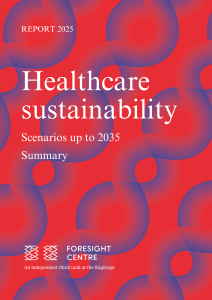Healthcare Sustainability

The Estonian Health Insurance Fund’s budget, which had been supported by additional funding during the COVID-19 period, has fallen into a long-term and deepening deficit. has now entered a long-term and deepening deficit. Starting from 2025, reserves will need to be used. Otherwise, the Health Insurance Fund’s budget would show a deficit of 160 million euros. This situation implies that approximately one-quarter of the reserves will be depleted within a single year.
Forecasts suggest that healthcare expenditure (increasing by 5–6% per year) will significantly surpass revenue growth (3.2% per year) over the next 15 years. Thus, the annual deficit is projected to reach 1.2 billion euros (1.7% of GDP) by 2040. By 2060, the deficit is expected to rise to 8.2 billion euros, amounting to 5.9% of GDP (Võrk and Piirits 2023). Unless additional resources are found, the Health Insurance Fund will have to extensively rely on its reserves or reduce the availability of healthcare services.
Previous analyses have repeatedly highlighted that the insufficient social tax-based funding to cover the growing costs is the main financing issue (Ministry of Social Affairs 2021, Foresight Centre 2020). Therefore, it is essential to diversify the financing models. Increasing the population’s contribution cannot be the main solution – Increasing household contributions cannot be the primary solution, as Estonia already has significantly higher household healthcare contributions compared to the EU average (OECD 2024) and impoverishment due to healthcare costs remains a challenge as well (Võrk and Piirits 2020).
A 2023 analysis summarising studies of Estonian healthcare financing identifies the following solutions.
- Increasing state budget transfers to the Health Insurance Fund. Currently, transfers are made only for pensioners; a more sustainable approach would include similar transfers for other comparable groups (e.g., children and students). This would help maintain the Fund’s budget balance for up to 15 years.
- Extending the health insurance tax base to other income types, such as dividends from state-owned enterprises and income from property sales. However, this measure is not considered a long-term solution
- Introducing a dedicated health insurance tax, aligned with the income tax base, could generate additional revenue of up to 0.4% of GDP. However, additional financing needs would surpass this revenue increase after 2027.
- Implementing an additional targeted tax specifically for the Health Insurance Fund, such as a sugar tax.
Key starting points of the research topic:
- New healthcare financing models. In the last decades, international experience and research have proposed various models to improve the efficiency of healthcare systems. Notably, value-based funding, including a broader treatment pathway and the provision of multiple services within a single funding unit, has gained attention.
- The role of private insurance. Private insurance is a growing trend in Estonia, but it is known to increase healthcare inequality. The 2023 meta-analysis states: “Additional analysis on the potential of private insurance provided by employers is needed. As international experience […] shows, private insurance rarely meets expectations, therefore more detailed analysis, monitoring and regulation are important”. There are also examples of so-called deductible private insurance in the world, i.e. people can have private insurance against a higher deductible from a certain level, which would set a ceiling for their deductible payments. In the 2020 report by the Foresight Centre, we estimated the cost of the insurance premium at 570–820 euros per year. Currently, however, we don’t know whether the market could create a suitable insurance offer.
- Precise prevention. Greater cross-use of personal data accessible by the state for better prevention of lifestyle diseases is one possible future direction for a personalised state, which can lead to better public health and thus hundreds of millions of savings for the state (Foresight Centre 2024).
- Funding and labour relations. Estonia had fewer doctors and nurses compared to the EU average in 2021. Doctor shortages are exacerbated by workforce ageing, with severe shortages particularly in family medicine – especially outside major cities – and psychiatry. Additionally, there is a persistent shortage of nurses across the healthcare system. The increasing number of workers leaving the medical system due to overload (Levila 2023) further increases the burden on those who remain, putting the state under pressure to find secure labour models for the future.
Main questions of the research topic:
- What alternative options exist for diversifying healthcare funding, and how would they impact healthcare availability in Estonia by 2050?
- How might the balance between personal contribution and state funding change in the healthcare system in Estonia by 2050?
- How would different funding models affect cost control, service quality and healthcare workforce succession?
The research stream has a strong connection with the research stream “Future Health Care” completed by the Foresight Centre in 2020.
Reports linked to the research
News linked to the research
-
10.11 2025Report: Estonia could learn how to control healthcare costs from the Netherlands
The expenses of the Estonian Health Insurance Fund significantly exceed its revenues, and the accumulated reserves will be depleted in the next five years. Other European countries in the same situation have cut healthcare services and increased people’s co-payments. According to the Foresight Centre’s new short report “Other countries’ experiences in managing healthcare budget deficits”, both solutions have worsened public health and deepened inequality.

 An independent think tank at the Riigikogu
An independent think tank at the Riigikogu 
